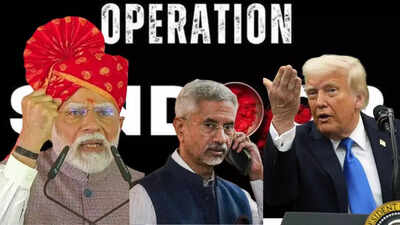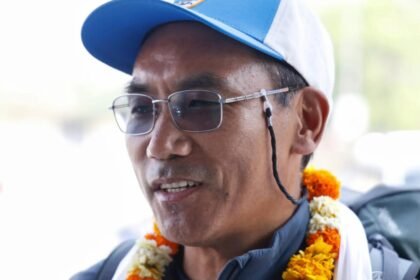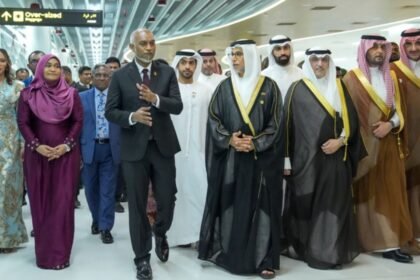NEW DELHI: In the aftermath of the Pahalgam terror attack and ‘Operation Sindoor’, a major question emerged on the global stage: Did US President Donald Trump mediate a ceasefire between India-Pakistan or was the decision completely bilateral?While Trump made several claims of brokering truce, India made it clear that the decision was bilateral and was made after Pakistan DGMO approached his Indian counterpart. It all started when Trump, in the middle of cross-border tension between India and Pakistan, claimed on social media that the United States had mediated a ceasefire. The announcement triggered a row as it was announced even before India or Pakistan’s official statement.However, from the outset of India-Pakistan tension, the US response was inconsistent. Following the April 22 Pahalgam terror attack, Washington oscillated between silence and vague commentary. On April 26, Trump brushed aside questions about the crisis, saying, “They will figure out one way or the other.”India, meanwhile, had already set the tone. It had communicated a clear doctrine: any terrorist provocation would invite a calibrated military response. That stance was made evident through ‘Operation Sindoor’—a precision strike campaign between May 6 and 9 targeting cross-border terror and military infrastructure.
‘Making a few calls isn’t mediation’
Speaking to the Times of India, Prof Rajan Kumar of the School of International Relations, JNU, pointed out the difference between informal diplomacy and structured mediation.“In international relations, making a few calls is not considered negotiation or mediation. Mediation requires laying out clear terms and conditions of a ceasefire. Trump’s gesture of reaching out to both PM Modi and the Pakistani leadership was acknowledged, but India responded because the conditions were already conducive for a ceasefire,” he said.According to Prof Kumar, India had powerfully conveyed its red line to both global and domestic audiences. “It had made clear that any terrorist attack would invite a response—limited strictly to terror camps. That message was sent through its military actions and the supporting evidence.”
Trump’s historical inaccuracy reveals poor geopolitical awareness
Dr Ashok Sharma, Visiting Fellow at the University of New South Wales Canberra at the Australian Defence Force Academy, speaking to Times of India, criticised Donald Trump’s understanding of the region’s history. “After the Pahalgam attack, he claimed that India and Pakistan had been fighting for centuries. That’s a clear historical inaccuracy—Pakistan was created only in 1947,” Dr Sharma said. “Statements like these expose a serious gap in geopolitical awareness and undermine the credibility of his remarks about mediating a ceasefire.”
Trump’s contradictions and self-congratulations
Trump’s commentary on the India-Pakistan standoff grew increasingly dramatic as events unfolded. On May 10, he posted on Truth Social:“After a long night of talks mediated by the United States, I am pleased to announce that India and Pakistan have agreed to a full and immediate ceasefire. Congratulations to both countries on using common sense and great intelligence.”However, in India, officials and analysts were quick to push back.“Trump has a bad habit of taking credit for everything,” Prof Kumar said. “He projects himself as a peacemaker—perhaps even eying a Nobel Prize. But in reality, he’s far removed from the ground. Despite his claims, there’s been no ceasefire success in Ukraine or Gaza. Even Netanyahu isn’t listening to him, while the US is negotiating with Iran—something Netanyahu opposes.”Prof Pushpesh Pant echoed similar sentiments: “Donald Trump is irrational and unpredictable. Any attempt to interpret his foreign policy through tweets is bound to be misleading.”
Trump’s India-Pakistan commentary: A timeline of contradictions
“Deeply disturbing news out of Kashmir. The United States stands strong with India against Terrorism. We pray for the souls of those lost, and for the recovery of the injured. Prime Minister Modi, and the incredible people of India, have our full support and deepest sympathies. Our hearts are with you all!”
April 23: In the immediate aftermath of the Pahalgam attack, Trump posted on X (formerly Twitter):
“Will figure out one way or the other.”
April 26: Three days later, Trump commented vaguely on his role during the crisis
“Oh, it’s so terrible! My position is I get along with both. I know both very well, and I want to see them work it out. I want to see them stop, and hopefully, they can stop now. They’ve gone tit for tat, so hopefully, they can stop now.” “And if I can do anything to help, I will—I will be there.”He added: “We just heard about it as we were walking through the doors of the Oval [Office]… They’ve been fighting for a long time. They’ve been fighting for many, many decades—and centuries, actually, if you think about it. I hope it ends very quickly.”
May 8: Just a day after Operation Sindoor was launched, Trump offered a generic appeal for peace
“That’s fundamentally none of our business.” He elaborated: “What Secretary Rubio said and certainly the President has said is we want this thing to de-escalate as quickly as possible. We can’t control these countries though. Fundamentally India has its gripes with Pakistan… But we’re not going to get involved in the middle of war.”
May 9: Vice President JD Vance, during an interview with Fox News, firmly distanced the US from any active role
“After a long night of talks mediated by the United States, I am pleased to announce that India and Pakistan have agreed to a FULL AND IMMEDIATE CEASEFIRE. Congratulations to both Countries on using Common Sense and Great Intelligence.”
May 10: President Trump dramatically claimed credit for bringing about a ceasefire
“I am monitoring the situation between India and Pakistan closely. I echo President Trump’s comments earlier today that this hopefully ends quickly, and will continue to engage both Indian and Pakistani leadership towards a peaceful resolution.”
On the same day (May 10), US Defence Secretary Marco Rubio said
Later, in another interview, Trump labelled the entire episode one of his “biggest successes,” claiming that tensions had reached near nuclear levels and that his backchannel diplomacy averted catastrophe. Trump continued to make these claims several times in last few days.
VP JD Vance distances US from India-Pakistan tensions
Adding to the mixed signals, US Vice President JD Vance, who was on a diplomatic visit to India during the Pahalgam attack, took a markedly different line.“That’s fundamentally none of our business,” he told Fox News on May 9. “We can encourage de-escalation, but we’re not going to get involved in the middle of a war.”This distancing came as India and the US announced deeper economic ties, with India agreeing to increase US imports, marginalising China. Trump’s camp portrayed this as another win for his “America First” trade policy.A Republican spokesperson claimed, “Trump’s deal-making genius is reshaping global trade.”
India draws red lines, not Washington
India swiftly rejected Trump’s assertion that the US mediated the ceasefire or used trade pressure to influence its decisions. The ministry of external affairs (MEA) issued a firm rebuttal:“From May 7, when Operation Sindoor began, to May 10, when military action ceased, there were conversations between Indian and US leaders. Trade issues did not come up in any of these discussions.”The MEA also reiterated India’s position on Kashmir: the only unresolved issue is the vacation of Pakistan-occupied territory.
India’s strategy vs Trump’s theatrics
The handling of the Pahalgam aftermath revealed two contrasting crisis management styles: India’s deliberate, policy-driven approach versus Trump’s flamboyant self-promotion.While Washington may have helped facilitate backchannel communication, Indian officials and scholars assert that New Delhi neither sought nor relied on US mediation.The ceasefire was, in the end, a product of India’s strategic clarity, not Trump’s diplomacy.
India’s Operation Sindoor
India launched Operation Sindoor on the night of May 6–7, carrying out precision missile strikes on nine terrorist camps in Pakistan and Pakistan-Occupied Kashmir (PoK), killing over 50 terrorists, including those linked to the Pahalgam attack.The operation targeted key sites including Jaish-e-Mohammad’s base in Bahawalpur and Lashkar-e-Taiba’s headquarters in Muridke. This marked a major escalation between India and Pakistan, resulting in four days of cross-border tensions, including airborne strikes in border states.The strikes followed the April 29 high-level meeting where Prime Minister Narendra Modi gave the armed forces “complete operational freedom” in response to the April 23 Pahalgam terror attack that killed 26 civilians.With the military phase of Operation Sindoor concluded, diplomatic efforts are now underway. India and Pakistan are both engaging in outreach to manage global perceptions and prevent further escalation.India has sent seven all-party parliamentary delegations to 25 countries, including United Nations Security Council (UNSC) members and influential global powers. The 10-day mission, comprising 51 political leaders and 8 former ambassadors, is aimed at countering Pakistan’s terrorism narrative and reaffirming India’s zero-tolerance stance on global platforms.






